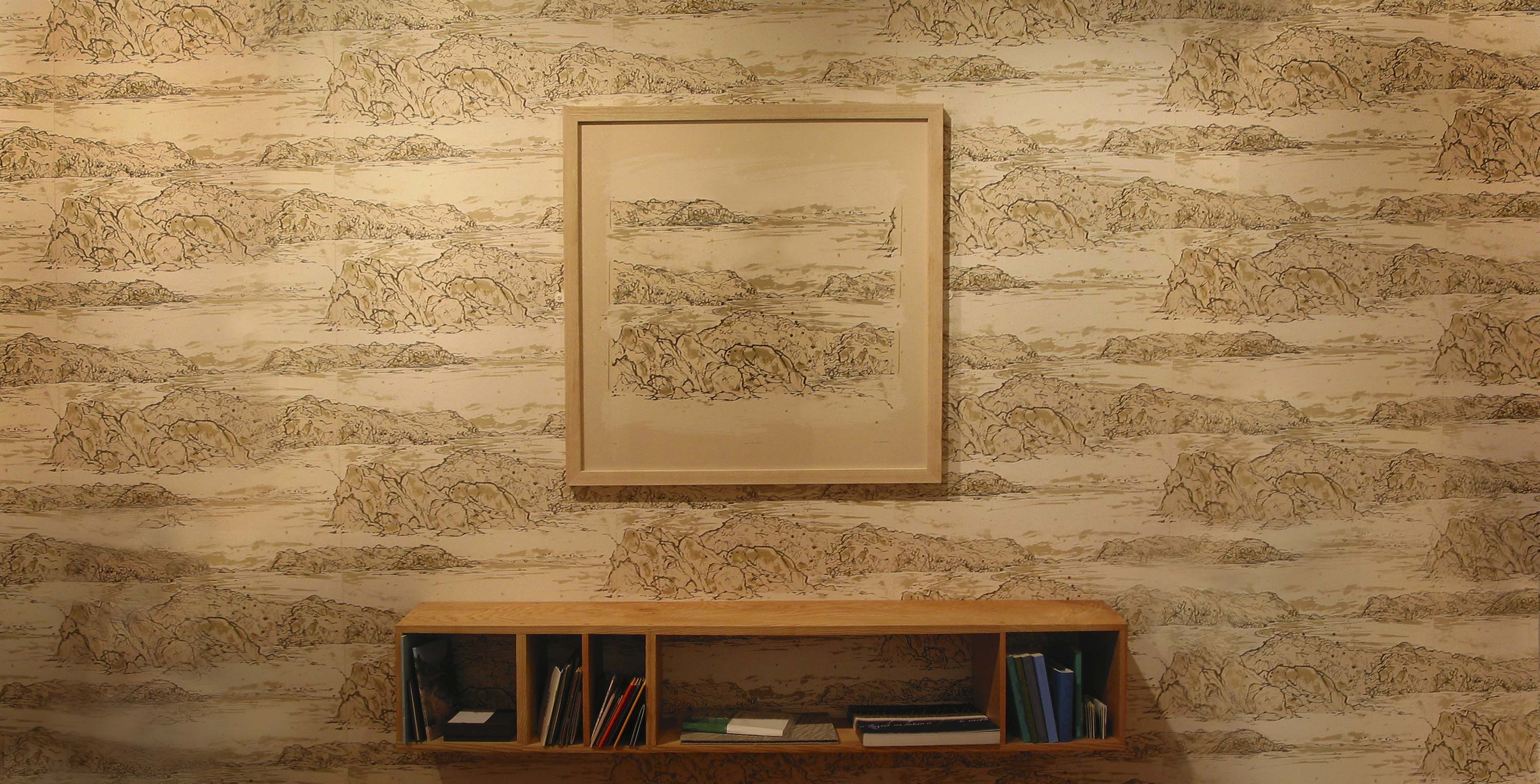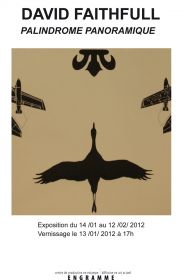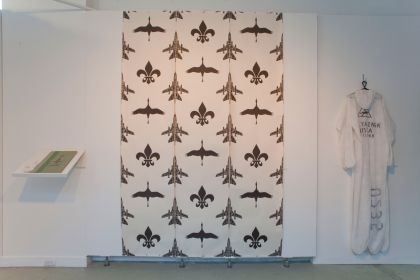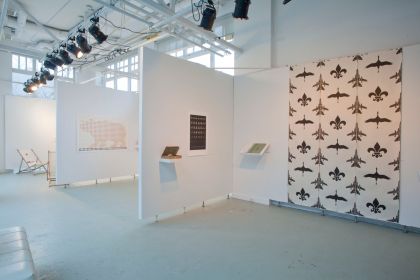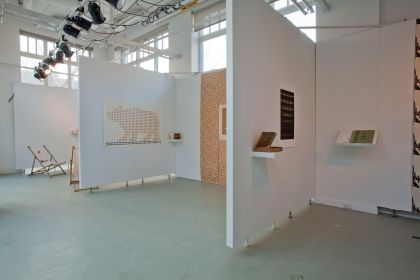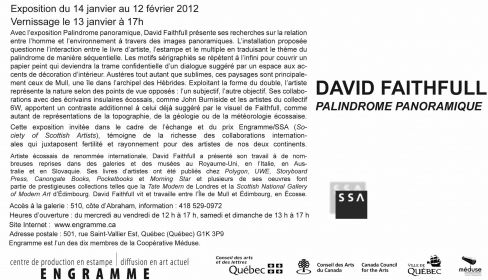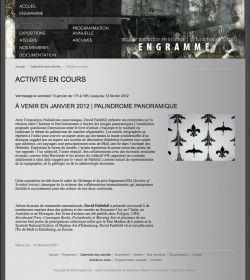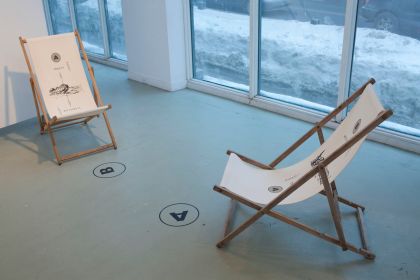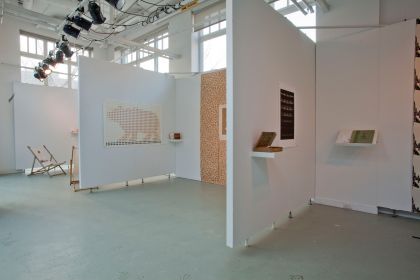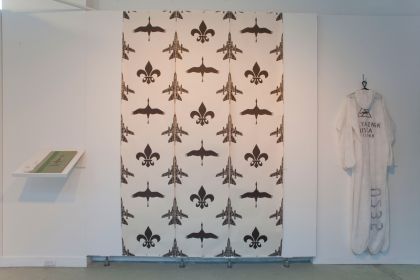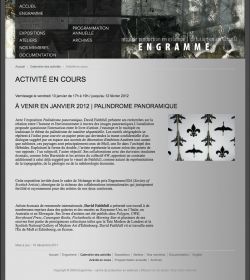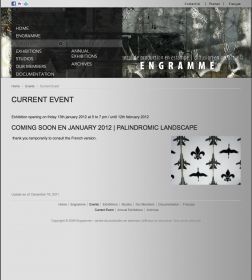Bunker Installation as part of David Faithfull's Palindrome Panoramique exhibiton at Engramme in Quebec City in 2011
Palindrome Panoramique (blog)
Solo exhibiton by David Faithfull at Engramme in Quebec City, Canada; awarded by the Gallery in January 2012.
PALINDROMIC LANDSCAPES
By David Faithfull
Palindromos: Running back again (Greek)
Many of the drawings, prints and Artists Books I have created, employ a palindromic or dual form. As well as representing the physical landscape from two diametrically opposite viewpoints, they portray visual concepts and texts, interpretable from contrasting perspectives, often subjectively following one approach and objectively the other.
Most of these investigations depict my responses to the landscape of Scotland, originally the Hebridean Island of Mull off the West Coast. This is a place of stark yet sublime beauty and an area I have found deeply inspiring since childhood. More recently these palindromic investigations have involved collaborations with poets and writers based on specific island residencies. These have included the Isle of Jura with writer John Burnside in 2009 and this summer on Inch Kenneth with artists collective 6°W.
The format of the Print or Artists Books gives me the opportunity to translate the Palindromic theme structurally and sequentially, utilising the sheet or page structure. Tide/Edit (fig 15) comprises of two continuous sequential courses or cycles. Read as Tide, the book covers a brief theory of tides and tide tables. Viewed as Edit, it a more personal interpretation of the tidal influences, describing various, mythological and fictitious characteristics.
The Tide/Edit series have been exhibited extensively and were shown at the Scottish National Gallery of Modern Art in 2002 as part of the exhibition NEW: Recent Acquisitions of Contemporary British Art, alongside the work of Tracey Emin and Damien Hirst and more recently at the Dean Gallery ARTISTS’ BOOKS: The Scottish Contribution, in Edinburgh in 2009.
Traigh Mhill, East looking west/West Looking East (fig 10), focuses introspectively from one direction, on the personal associations of memory and sensory response to a certain heathland/shoreline region. From the other antithetical viewpoint, I detail more objective, topographical, geological, meteorological and environmental particulars of the area.
Other projects have included the series Jettison (figs 6, 7 + 9) investigating the crash of a Tornado Jet, near the sight of Torness nuclear power station in southeast Scotland. Jettison 1: reflects an official manual or report, details the flight crash investigations and documents wreckage salvaged from the shore close to the crash site. Jettison 2: constructed as a flip-book and accompanying boxed wreckage multiple, portrays the final flight path of the jet, from one viewing, and the ejector seat rotation and motion from the other.
Media coverage for JETTISON included me undertaking an extensive interview on BBC Scotland’s The Art Show in 2005.
The print and Artists Book Jura (fig 1) depicts the island landscape from two diametrically opposing viewpoints, approaching the isle from the east and eventually departing to the west. This collaboration with the Scottish Book Trust and the Jura Distillery, was first published in the Spirit of Jura by Polygon in 2009. The original sketchbook imagery was unusually published as a ‘visual’ chapter alongside the ‘words’ of a selection of internationally renowned writers.
Jura received extensive media coverage including the Times and the Scotsman. Both myself and the poet were interviewed live on Radio Scotland’s Book Cafe in April 2009 and the piece was on tour last year in Scandinavia as part of the Limfjord Book Festival exhibition Place of Interest.
Earlier collaborative Palindromic projects, include The Gaelic Arts Agency’s The Great Book of Gaelic, created in 2002. This was exhibited in Nova Scotia in 2009 and Cape Breton in 2010 as part of its continuing world tour. This was the first project in which I utilised oak gall ink. Based on a medieval recipe, I collect the galls from oak trees in the area I’m working in (fig 8), and use this locally sourced ink, together with freshly collected reed pens, to intensify the authenticity of the landscape I’m drawing and depicting.
The majority of my prints and Artists Books are screen-printed, employing various experimental materials and both traditional and digital print processes. This experimentation is clearly demonstrated in the recent commission for the Bank of Scotland in 2007, to create a pair of prints incorporating shredded bank-notes. The ‘Bull/Bear Market’ (figs 11 + 12) project investigates the financial world, particularly the share markets, incorporating actual shredded money from discarded and withdrawn Bank of Scotland bank-notes. The subject matter reflects the fiscal worlds’ relationships with ‘Bull’ and ‘Bear’ motives and markets, represented as the two animals, in pixilated 'coin' and outline forms. Whilst not strictly demonstrating a Palindromic Landscape form, they certainly display a sense of visual, conceptual and social dichotomy.
To satisfactorily exhibit and present many of these palindromic ideas, prints and Artists Books, I created the touring exhibition Inkubator in 2007. This comprised a series of themed spaces including the Log Cabin (fig 4) and the Landscape (fig 5) again reflecting the positioning of the artists and the artwork within the landscape. This was first exhibited at Edinburgh Printmakers to extensive and acclaiming reviews, included Printmaking Today. One reviewer described it as: “the best means of looking at this most underrated and misunderstood art-formsI have ever seen.” (Iain Gale, Scotland on Sunday, 22.4.07)
For the Inkubator exhibition in Durham, England, in 2009, I adopted a new themed space, the Bunker (fig 3). This incorporates many of the earlier Jettison pieces, as well as more recent investigations into military, civil and nuclear bunkers. This has subsequently been shown at the SSA annual show in Edinburgh and in Slovakia and at Impact 7 in Melbourne this year.
For the Engramme exhibition in January 2012, I have included many oof these Palindromic works. Although the themes and elements of the more expressive hand-drawn Landscapes possibly reflect this concept more clearly, all the works on display contain this visual duality. The Log Cabin and Bunker are paradoxes within the Landscape, the military plane crash and the nuclear power station of the Jettison series are more aggressive reminders of our contemporary relationship with the environment. And even the Barox (fig 13) print, is based on an East Coast of Scotland/West Coast of Scotland paradox. The romantic idea of desolate Hebridean shores, mirrored with an investigation into the decaying Victorian beach resorts, scattered all around the British coastline, in this case the old fruit machines from the beach arcades on Portobello promenade, east of Edinburgh.
Photos by Yvan Binet
 |
 |

